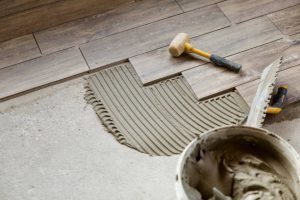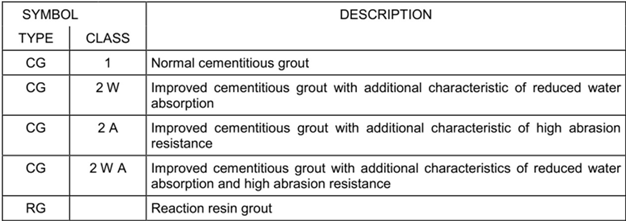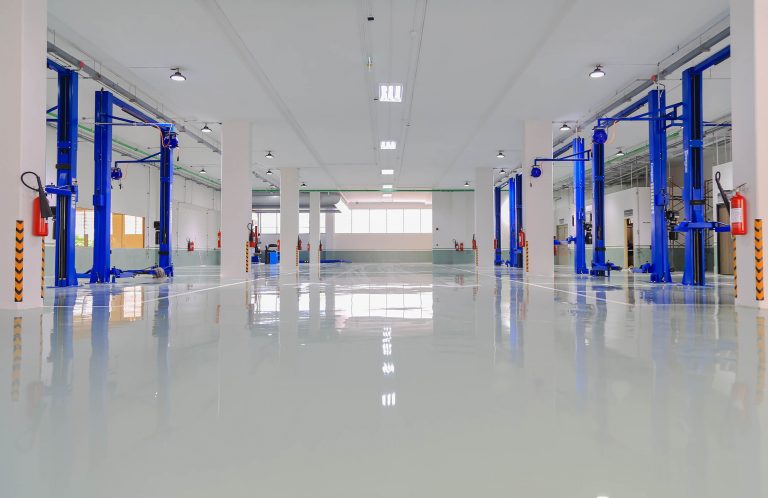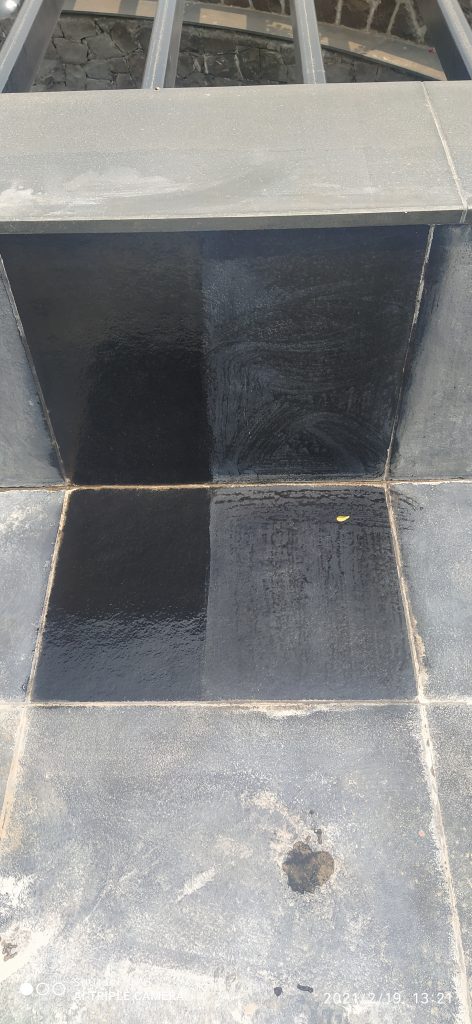Our-Services
01.TILE ADHESIVE
Tile adhesive is ready – mixed and specially formulated from OPC, selected fine sand and additives to improve its essential properties for laying tiles or stones. High – performance tile adhesive can be used to lay tiles on any kind of substrates. While cement is quite strong when used to hold bricks together, it does not do a very good job when used to install tiles or stones. After a few years, tiles often become loose and even come out in some cases. With the correct Tile Adhesive, this is never a problem. It can hold the tiles tightly in place for decades to come. This makes it especially reliable for installing wall tiles
The important of tile adhesives :
- Fast and efficient
- Easy to use
- Better bonding strength
- Applicable on various substrates
- Thinner layer
- Dues to its low shrinkage property, it gives excellent adhesion
- It is very flexible for accommodating the thermal and also physical movement
- It requires almost no amount of curing and needs no mechanical or hacking of the surface
- The floors where tile adhesive is applied can be usable only after 24 hours
- No soaking of any tile are required in any way.
02.TILE GROUT
Grout is generally a mixture of water, cement, and sand and is employed in pressure grouting, embedding rebar in masonry walls, connecting sections of pre-cast concrete, filling voids, and sealing joints such as those between tiles.
“The best way to choose grout is to decide if you want it to match, complement, or contrast the tile,” says Walker.
If you want to highlight the pattern your tile creates, a contrasting colour is best. If you’re trying to unify your tile, such as with a wood look tile floor, go for a close match that’s a little bit lighter than your tile.
Types of Grout for Ceramic Tile :
- Unsanded grout: This is used for wall tiles where the grout joint is less than 1/8” wide.
- Finely sanded grout: This is used for floor tiles where the joints are 1/8” to 3/8” wide.
- Epoxy grout: This consists of an epoxy resin and hardener. Epoxy grout for ceramic tile is highly resistant to stains and chemicals and has a tremendous bonding strength. It is ideal for countertops and other areas susceptible to stains.
03.WATER-PROOFING
Waterproofing is the process of making an object or structure waterproof or water-resistant so that it remains relatively unaffected by water or resisting the ingress of water under specified conditions. Such items may be used in wet environments or underwater to specified depths.
Type of Products:-
- Polyurethane
- Cementitious Coating
- Acrylic Coating
- HDPE
- PVC
- TPO
- Colter Epoxy
- Bituminous.
04.Self Leveling
Self-leveling concrete is typically used to create a flat and smooth surface with a compressive strength similar to or higher than that of traditional concrete prior to installing interior floor coverings. When self-leveling concrete is poured, it has a viscosity similar to pancake batter. A gauge rake is used to move it into place without spreading it too thin. The finishing is then done by lightly breaking the surface tension of the product using a tool called a smoother. A self-leveling compound is ideal in smoothing out uneven floors. Concrete floors may have bumps, especially if poured incorrectly. A self-leveling compound will prevent this, although it’s not always a perfect solution.
When self-leveling concrete is poured, it has a viscosity similar to pancake batter. A gauge rake is used to move it into place without spreading it too thin. The finishing is then done by lightly breaking the surface tension of the product using a tool called a smoother. The polymers in the self-leveling mix keep the viscosity of the product such that it remains uniform in composition from top to bottom without the sand aggregates sinking to the bottom of the installed layer. The typical installation thickness of these products is about 0.25 inches (6mm) to ensure there is enough mass present for the material to flow, although some self-leveling products now exist that can be installed at an average thickness of only 0.125 inches (3mm).
05.EPOXY FLOORING
Epoxy floor coatings are commonly used for commercial and industrial flooring. Epoxy coatings are normally applied over concrete floors to provide a high-performance, smooth, and durable surface that can last many years and withstand heavy loads. Many industrial sites, warehouses, and commercial buildings rely on epoxy floors to maintain clean and safe conditions for workers, equipment, and inventory.
Epoxy Floor Coating Preparation:
An epoxy coating requires a clean and slightly porous surface to adhere properly. Epoxy may not bond to sealed or polished concrete. The concrete also must be fully cured. Before apply epoxy floor coating, it is important to patch and repair all major cracks and chips in the concrete surface and to remove all grease. If the concrete is old, test the surface for previous layers of epoxy or other products that might have been applied over the years. To test for sealant, pour a small amount of water onto the floor. It should soak in. If the water beads on the surface rather than soaking in, it likely has been sealed and may not be suitable for an epoxy coating. Before applying an epoxy coating, make sure that the temperature is suitable, and follow all manufacturer’s recommendations. Unfavorable temperatures can cause the epoxy to bubble and peel. Epoxy is a two-part liquid that you mix before application. Once the product is mixed, you have a limited time to apply the epoxy coating before it starts to harden.
Epoxy Primer Formulas :
Depending on the product being applied, you might need to apply an epoxy primer and finisher coat. The primer is applied just like paint and is allowed to settle for several hours before the epoxy goes on. To apply the primer, cover the floor with a thin layer of water, then spread the primer with a roller pin on a pole, spreading it out in a thin layer over the entire floor. Let the primer dry, then apply a second coat. The finisher is applied in the same manner as the primer but without the water layer.
Epoxy Floor Coating Advantages :
Epoxy floor coatings offer many advantages when compared to other traditional coatings applied over concrete:
- Creates a shiny high-gloss surface that can significantly increase the brightness of interior areas
- Offers a hard-wearing durable surface able to withstand heavy and continuous traffic
- Quick and easy to install, requiring no layout, cutting additional adhesives, or special tools or equipment
- Durable and easy to clean
- Ideal for warehouses and industrial applications
- Resists oil stains and water
- Creates a seamless surface that can last many years
- Can be combined with paints and colours to mask off chips and cracks
- Provides a chemically resistant surface ideal for manufacturing plants
- Offers enhanced safety when the surface contains anti-slip additives
- Can be applied in different patterns to create visible driveways and/or identify walkable areas
- Prevents wear and tear on existing concrete floors
- May be compatible with self-leveling products that can be applied over new or old concrete, depending on the product
- Requires little or no major maintenance.
06.PU FLOORING
Polyurethane Floors are an alternative to epoxy flooring. They can be either one-component (moisture curing) or two component when they cure as a result of mixing two components together.
The most common forms of polyurethane flooring are:
- Roller and squeegee applied Floor Coatings
- Clear coats used to protect surfaces from scratching
- Varnishes for wooden floors
- Thicker floors applied with a trowel at a thickness of 2-3 mm
- Cement based polyurethane floor often applied at thicknesses up to 1cm
Compared to Epoxy Floors, they tend to be softer and have a higher elasticity.
Polyurethane Flooring: Where do we install such floors?
We often see the use of PU Floors in applications where epoxy may not be suitable. Perhaps the most widespread use, of polyurethanes is in multi-storey car parks. Due to the elastic nature of the coating, they can act as a waterproofing layer for each floor.
Polyurethane floors are also suitable for outdoor applications. Epoxy is not resistant to the sun’s UV rays, but aliphatic polyurethanes are. Aliphatic polyurethane floor coatings are flexible, which makes them a perfect solution when you want the coating to act as a waterproofing surface on top of the overall protection of the concrete. These coatings are also scratch resistant. Therefore in commercial applications, we often apply a clear polyurethane coat over an epoxy floor, as a protective non scratch layer.
The Elasticity of Polyurethane Floors has many advantages?
Another common application of polyurethane floors are in freezing chambers. Epoxies don’t to work well once the temperature drops below Zero Celsius. Once the temperature drops below zero, they tend to break since they just don’t have the elastic properties to withstand such low temperatures. This is where we commonly apply a 2 mm thick polyurethane floor coating. It creates a nice elastic surface that allows the frequent movement of pallet trucks without any damage.
We also install thick elastic PU coatings in gyms, schools and commercial spaces. Their texture is soft and not as glossy. The elastic surface tends to absorb some of the impact from foot traffic, and therefore makes it a friendlier surface for people to walk on. Especially in schools, sports facilities and even yoga studios, such floor coatings are considered convenient and safe.
Finally, some types of PU floors are commonly used in heavy duty industrial applications. Cement based PUs are often applied on surfaces that need to be cleaned with very hot water. For example in food manufacturing, if you try to washing a conventional coating with water at 70 degrees Celsius, the surface will very likely undergo a heat shock that could cause the surface to peel. A cementitious polyurethane cement can withstand such impact. Furthermore such cementitious surfaces are also resistant to many different types of acids.
Installation of Polyurethane Floor Coatings?
Installing such coatings should only be done by professionals. Whereas epoxy is easier to use, polyurethane floor coatings are far more challenging to apply.
Polyurethane is very sensitive to moisture. The slightest bit of moisture can cause a chemical reaction. We are not just talking moisture in the substrate, but also moisture in the atmosphere. Polyurethane, once cured is very difficult to re-coat without doing some prior surface preparation first. But even trying to sand a polyurethane surface is challenging. For example, sanding an epoxy surface is fairly easy. But a PU coating due to its anti-scratch nature does not scratch as easily.
I have talked in the past about my nightmares with clear coatings. Polyurethane clear coatings often have problems with surface tension. Another issue is that they are very sensitive to micro-dust, which can lead to the dust getting trapped. Cementitious polyurethanes require anchoring prior to applying the floor. Furthermore, since most PUS tend to cure quite quickly you need a well organized and experienced staff to apply the floor quickly without any troubles.
07.Marble or Stone Sealer
Stone sealing is the application of a surface treatment to products constructed of natural stone to retard staining and corrosion. All bulk natural stone is riddled with interconnected capillary channels that permit penetration by liquids and gases. This is true for igneous rock types such as granite and basalt, metamorphic rocks such as marble and slate and sedimentary rocks such as limestone, travertine and sandstone. These porous channels act like a sponge, and capillary action draws in liquids over time, along with any dissolved salts and other solutes. Very porous stone, such as sandstone absorb liquids relatively quickly, while denser igneous stones such as granite are significantly less porous; they absorb smaller volumes, and more slowly, especially when absorbing viscous liquids.
Benefits of Marble sealer :
- Staining
- Salt Attack
- Efflorescence
- Acid Attack
- Picture Framing
- Freeze-thaw Spalling
Why Seal?
Natural stone is used in kitchens, floors, walls, bathrooms, dining rooms, around swimming pools, building foyers, public areas and facades. Since ancient times, stone has been popular for building and decorative purposes. It has been valued for its strength, durability, and insulation properties. It can be cut, cleft, or sculpted to shape as required, and the variety of natural stone types, textures, and colours provide an exceptionally versatile range of building materials. The porosity and makeup of most stone does, however, leave it prone to certain types of damage if unsealed.
Staining is the most common form of damage. It is the result of oils or other liquids penetrating deeply into the capillary channels and depositing material that is effectively impossible to remove without destroying the stone.
Salt Attack: Occurs when salts dissolved in water are carried into the stone. The two commonest effects are efflorescence and spalling. Salts that expand on crystallization in capillary gaps can cause surface spalling. For example, various magnesium and calcium salts in sea water expand considerably on drying by taking on water of crystallization. However, even sodium chloride, which does not include water of crystallization, can exert considerable expansive forces as its crystals grow.
Efflorescence is the formation of a gritty deposit, commonly white, on the surface. Efflorescence is usually the result of mineral solutions in the capillary channels being drawn to the surface. If the water evaporates, the minerals remain as the so-called efflorescence. It also can be the result of chemical reaction; if badly prepared cement-based mortar is applied to maintain the stone in position, free calcium hydroxide may leach out. In the open air the lime reacts with carbon dioxide to form water-insoluble calcium carbonate that might take the form of powdery efflorescence or dripstone-like crusting.
Acid Attack: Acid-soluble stone materials such as the calcite in marble, limestone and travertine, as well as the internal cement that binds the resistant grains in sandstone, react with acidic solutions on contact, or on absorbing acid-forming gases in polluted air, such as oxides of sulphur or nitrogen. Acid erodes the stone, leaving dull marks on polished surfaces. In time it may cause deep pitting, eventually totally obliterating the forms of statues, memorials and other sculptures. Even mild household acids, including cola, wine, vinegar, lemon juice and milk, can damage vulnerable types of stone. The milder the acid, the longer it takes to etch calcite-based stone; stronger acids can cause irreparable damage in seconds.
Freeze-thaw Spalling results when water freezes in the surface pores. The general term is Frost weathering. The water expands on freezing, causing the stone to spall, crumble, or even to crack through.
Protecting Stone
The longevity and usefulness of stone can be extended by sealing its surface effectively, so as to exclude harmful liquids and gases. The ancient Romans often used olive oil to seal their stone. Such treatment provides some protection by excluding water and other weathering agents, but it stains the stone permanently.
During the renaisance Europeans experimented with the use of topical varnishes and sealants made from ingredients such as egg white, natural resins and silica, which were clear, could be applied wet and harden to form a protective skin. Most such measures did not last long, and some proved harmful in the long run.
Modern stone sealers are divided into 3 broad types :
- Topical Sealers : Generally made from polyurethanes, acrylics, or natural wax. these are sealer may be effective at stopping stains but, being exposed on the surface of the materials, they tend to wear out relatively quickly, especially on high traffic area of flaring.
- Penetrating Sealers: The most penetrating sealers use silicones, floor polymers and siloxanes, which repel liquids. These sealers penetrate the surface of the stone enough to anchor the materials to the surface.
- Impregnating Sealers : Uses silane or modified silane. these are a type of penetrating sealer, which penetrate deeply into the materials, impregnating it with molecules which bond to the capillary pores and repels water and /or oils from within the material.











